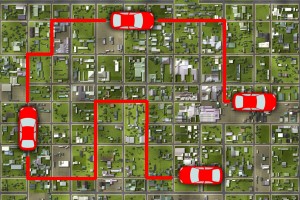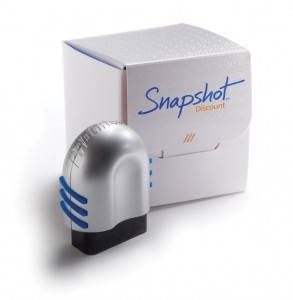A study by a handful of university professors in Colorado claims user-based insurance tracking programs installed in millions of vehicles can collect data that shows where drivers are going, unbeknownst to most users of the technology.
Professors from the University of Denver took 30 unique automobile trips around the Denver area. Some trips started at an office and ended at home, some were from a home to the grocery store, other trips were to drop off kids at school and others were social visits.
Using a device similar to what many insurance carriers offer, the professors tracked the driver’s speed and distance, then compiled the numbers and used basic maps to come up with what they called a “simple algorithm” that told them with a high degree of accuracy where the driver was going.
The authors of the study highlighted the fact that the device they used in their tests did not employ global positioning coordinates. Many devices on the market do not incorporate GPS as a way to alleviate privacy concerns that come with gathering information that gives a persons’ fixed position on the planet.
It turns out they didn’t need GPS to pinpoint a driver’s destination.

- A study claims telematics data can show where drivers are going, unbeknownst to most users of the technology.
As a result of the study the authors called for “more transparency” from carriers offering UBI, or telematics, products, which can earn drivers a discount if the data collected by the devices bears out their safe driving practices.
“Given the privacy issues surrounding the geographic tracking of individuals, many solutions explicitly claim that the customer’s GPS coordinates are not recorded,” the authors state in their study. “Although revealing driving habits can give us access to a number of innovative products, we believe that the disclosure of this data only offers a false sense of privacy. Using speed and time data from real world driving trips, we show that the destinations of trips may also be determined without having to record GPS coordinates. Based on this, we argue that customer privacy expectations in non-tracking telematics applications need to be reset, and new policies need to be implemented to inform customers of possible risks.”
One of the authors of the study, Rinku Dewri, an assistant professor in the Department of Computer Science, explained that what the study shows is there is less privacy when using a UBI than insurers are claiming.
“Mostly we are asking for more transparency from the ones who are offering these programs,” Dewri said, adding that UBI users are given a sense when they sign up for the programs that the data can’t be used to track them.
Dewri, who is also involved in the Colorado Research Institute for Security and Privacy, also raised questions over how such information would be used, whether it will be shared with others, and the security of that information, since ensuring it can’t be taken from carriers and used by criminals or others is now a concern.
Counter
“The study takes a very high intensity approach to tracking a single vehicle,” argued Timothy B. Nee, president of Dorman Consulting Associates, a part of TEACH Insurance LLC, which offers training and consulting to the property/casualty industry.”It’s hard to see what person or group – outside a government – would have similar resources available to track a single vehicle. This calls into question whether this privacy concern is more than a theoretical one.”
Nee also scoffed at the notion that people who sign up for UBI expect a high level of privacy.
“Most Americans realize that there are two groups of people who are monitored regularly as they move about the country,” Nee said. “The first group is monitored involuntarily by a court order requiring that tracking device be attached to their ankle. The second group includes everyone else, almost all of whom volunteer each day to be monitored by placing a mobile phone in a purse or pocket.”
Nee noted that software giants Google and Apple offer highly popular smartphone devices that track users more than most realize, and recent events have put in the minds of U.S. citizens that their government and its National Security Agency may be doing more electronic surveying that was previously believed.
“We have since learned from Edward Snowden that the NSA can and does monitor Americans regularly, sometimes directly and sometimes through meta data,” Nee said. “Again, most of us shrugged, agreed it was an outrage, and have moved on, essentially unfazed.”
Just what is being done with the UBI information varies by carrier, but largely it is sifted through for the information carriers need to make good underwriting decisions – and oftentimes the information beyond that never even makes it to the carrier, according Nee.
“Some devices process a portion of the data on the actual device, sifting out data that is considered imperfect or non-essential,” Nee said. “This saves carrier money on data transmission, just as it would on a customer’s mobile phone plan. Other devices transmit all the data to the carrier, which then must parse through it.”
Concerns
Robin Harbage, director global head of sales and product delivery of usage-based insurance for professional services company Towers Watson, agreed with the authors’ call for transparency.
“You need to be transparent about what you’re collecting,” Harbage said. “I think it is absolutely critical for insurers to be transparent with their client.”
Towers Watson said it prescribes data collection standards that outline steps to good transparency to the 30-plus carrier clients it deals with.
The acceptance of UBI is a few steps short of unanimous, while privacy concerns don’t rank too high among those polled, according to a survey from the company in September.
The Towers Watson survey shows nearly eight-in-10 respondents are willing to either buy a UBI policy or willing to accept the concept. The survey was conducted in seven countries, including the U.S. and Canada, with more than 1,000 participants from each country.
When asked for their feelings on UBI if insurers were to guarantee drivers’ premiums would not rise, the percentage of acceptance rose to 89 percent, according to the survey.
“They clearly see value here,” Harbage said.
Drivers taking the survey showed the most interest in vehicle theft tracking (83 percent), automated emergency response (82 percent) and vehicle wellness reports (79 percent).
“Privacy wasn’t even near the No. 1 issue,” Harbage said.
The survey showed 41 percent expressed fears that insurers would share their data, while 42 percent were concerned insurers will monitor or track their driving destinations. Forty-nine percent were worried their premiums would increase.

- Progressive’s Snapshot tracks a driver’s safe and unsafe habits and can make good drivers eligible for discounts.
Progressive Corp., the fourth-largest U.S. auto insurer, is one of the biggest and best known supporters of UBI through its Snapshot program.
According to the Mayfield, Ohio-based insurer, more than 1.6 million drivers have signed on to use Snapshot since 2008, and since that time the company has collected more than 8 billion miles of driving data.
Despite the massive collection of data, that information is not shared with other companies, nor does Progressive care where its drivers are headed, said Progressive spokesman Jeff Sibel.
“We’re not concerned about where a person’s going,” Sibel said when told about the study from the University of Denver professors.
Sible emphasized that the voluntary program doesn’t have GPS functionality, and the data the carrier does retrieve is not shared.
“It does not have GPS functionality, so we don’t know where you’re going,” he said. “We don’t share our data with anybody.”
The focus of the program is to look at how many miles a driver goes, safe driving and whether a driver is on the road at safe hours, he added.
Rate Setting
A possible legal or regulatory speed bump could arise if carriers represent they do not use the telematics information for purposes other than to offer discounts, and then it’s discovered the use of that data goes beyond offering discounts, said William Gausewitz, a partner at law firm Michelman & Robinson’s Sacramento office.
“If the company says we don’t track geographical data, and they use the raw data they do collect and massage or extract geographical data from it, that will probably be in violation of the various state practice laws,” Gausewitz said. “They will be accused of misrepresenting what they’ve done.”
Gausewitz, who was California’s deputy insurance commissioner for policy and regulation from in 2007 to 2009, said that many states already make it illegal or difficult to use UBI to offer discounts, including Alaska, California Hawaii, Indiana North Carolina and Tennessee.
There are various ways to rightly or wrongly use the abundance of data collected from UBI devices, but among the greatest concerns is that the data could potentially be used for the discriminatory practice of redlining, according to bad faith expert Suzanne M. Ganier, president of ALEXI Professional Services Inc. in Mandeville, La.
“There could be discrimination issues that come up with how the data is used,” Ganier said.
Ganier believes that if carriers can track where drivers are going, they will know precisely which geographic areas they are driving.
Then those carriers can base rates and coverage offered on that data, surmised Ganier, who called it “a backdoor way to get around rating by territory or rating by ZIP code.”
“I can definitely see a carrier making an argument you’re a higher risk because you’re driving through this territory,” she said.
The Study
The point of the study was to show how easy it is to track a driver’s destination and collect data beyond what the typical UBI user expects is being collected, according to Dewri.
He emphasized that few facts were required to pinpoint the locations of where drivers were going. Using “quasi-identifying information” like traffic stops, driving speed and turns from the data, the authors matched them to publicly available map information to determine potential destinations of a trip.
The authors began their study with the assumption that it is known where person began their trip, as auto insurers typically know where a person parks their vehicle overnight.
Then the professors added in bits of data, such as speed and distance covered. If, for example, the speed dropped to zero, the authors made an assumption the driver was waiting at an intersection or a stop sign.
Initially the data lead to 100 to 200 destination possibilities for a trip, according to Dewri, who said those possibilities were easily narrowed down from there.
For a driver who logged average non-rush-hour speeds of 35 mph, for example, all route possibilities going through a highway could be eliminated. Honing down the data in this method the algorithm nailed down where a person went on 18 out of the 30 trips. Obviously, probabilities of a particular destination increased when a person repeated a trip
A non-scientific mind may struggle to put it together, but knowing how to conduct a graph search and knowing basic probability theory is all it took to figure out where drivers were going, according to the professor.
“These are things an undergraduate student knows,” Dewri said. “Coming up with the algorithm we came up with is not a big deal.”
Sible with Progressive isn’t impressed with the authors’ findings, saying guess work and common sense can also tell you where most drivers are headed during their daily routine.
“If you see five consecutive days where starting at 8 .m. Monday through Friday that person’s driving 11 miles, most likely that person’s going to work,” Sible said.
Beside asking for more transparency and calling attention to the need to question how the telematics information is being used by insurers, Dewri expressed concern over how secure that data is being made.
“What if someone breaks into your system and takes it forcefully?” he hypothesized.
Data Cleansing
According to Nee, most carriers cleanse the data they get from UBI devices, and discard partial trips or other unusable information, which narrows the available data set to only a portion of the original data.
The data is then run through a performance model for scoring, which essentially compares a customer’s driving performance to that of all other customers based on the actual loss history of all drivers being evaluated.
As a matter of security, carriers are hesitant to store much of the data, especially if it is personally identifiable, according to Nee.
Another reason carriers don’t store much of this information is because the volume of data easily runs into the petabyte range. A petabyte is roughly 1,000 terabytes, and there are more than 1,000 gigabytes in a terabyte.
Finally, carriers don’t want to gather or keep information on where each customer has driven to avoid having to turn it over or get involved in any unrelated legal entanglements, Nee said.
“Can you imagine how many divorce attorneys would subpoena information on a suspected wayward spouse?” Nee said.
Agents
Still, to better service their clients Nee said agents should pay close attention to which carriers offer UBI, what they offer and how it may benefit their clients.
“First, agents should remind their customers that not all insurance carriers offer the same coverage, especially in terms of quality customer service or claims handling,” Nee said. “It is not all about price. Beyond that, when deciding among carriers with similar coverage, claims handling, and price, it is worth trying a carrier’s program. This is especially true if the prospective carrier will let the customer test drive the program while staying with their current carrier.”
Agent Jane Anthony, who is with Trident Insurance Agency in Devon, Pa., isn’t recommending UBI to any of her clients, not only because of privacy concerns but because she believes the data being collected may give a faulty snapshot of whether a driver is truly being safe.
Anthony, who specializes in getting insurance for high net worth individuals, test drove the device from Progressive as an agent six months ago.
“You don’t see all the information they are collecting on you,” she said. “You don’t see all the information they collect, and they collect a lot more that you don’t know about.”
Drivers receive data on hard breaking, or fast acceleration, but Anthony is convinced there is more data that’s being collected that the driver isn’t aware of, such as how many miles are being driven each day, which isn’t on the report sent to the customer.
She’s also concerned that the data from the device isn’t telling the whole story of whether a driver is a safe, or a defensive driver.
“The new ABS breaks that have been around, a lot of people are still pumping them or putting them on before they have to,” Anthony said. “With the way Snapshot works, it comes through as a hard break.”
She added, “Also during rush hour, when you’re constantly hitting your breaks, there’s no way to show you were just driving defensively.”
(This article was originally published on Insurance Journal’s website. Reporter Don Jergler is the West Coast editor of Insurance Journal.)




















 The Insurance Data Paradox: Structure Creates Flexibility
The Insurance Data Paradox: Structure Creates Flexibility  Former MLB Player Charged With Insurance Fraud in Florida
Former MLB Player Charged With Insurance Fraud in Florida  Triple-I: Insurance Economic Drivers Outperform Overall U.S. GDP
Triple-I: Insurance Economic Drivers Outperform Overall U.S. GDP  Uncertainty Keeps Prices Up; No Prior-Year Loss Development: Travelers
Uncertainty Keeps Prices Up; No Prior-Year Loss Development: Travelers 



